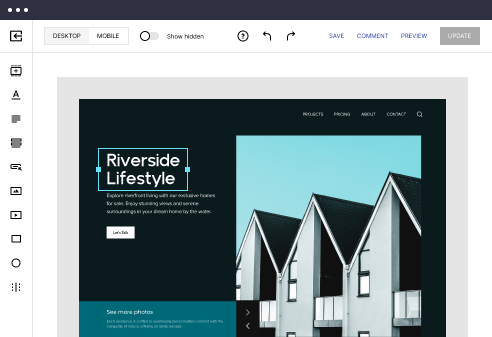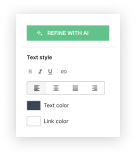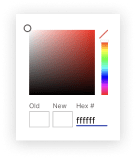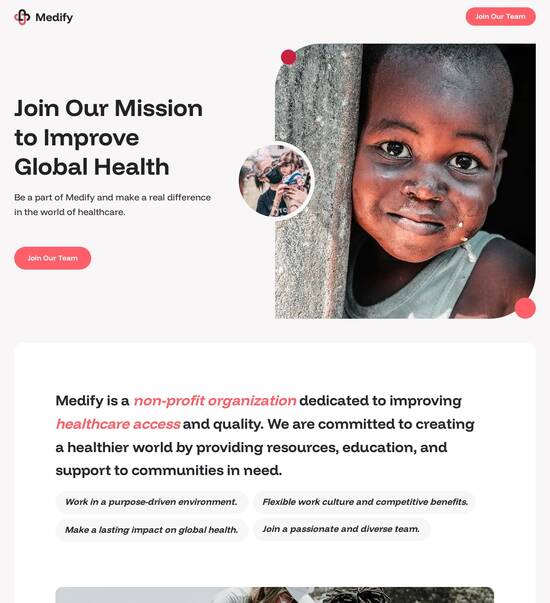
Event registration page template for Node.js developers
Explore Similar TemplatesAbout template
Master your online marketing with this builder for event registration page template for Node.js developers. Try more tools to create an immaculate landing page.
Recommended templates
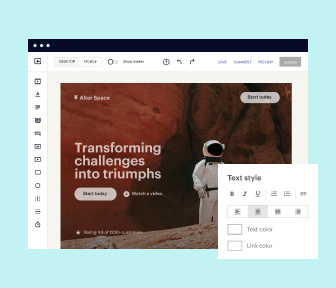
Easy to build without coding
With the intuitive drag-and-drop builder, anyone on your team can create high-converting pages without any knowledge of code or design. Make enhancements to your landing page with custom widgets using Javascript, HTML/CSS, or third-party scripts.
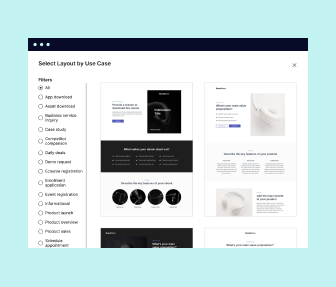
Multiple layouts for any industry and goal
Select from 500+ landing page layouts built to boost conversions across industry-specific scenarios. Customize them by adjusting fonts, adding images, and generating on-brand content with the AI assistant. Quickly scale with Instablocks® and Global Blocks that you can save, reuse, and update globally.
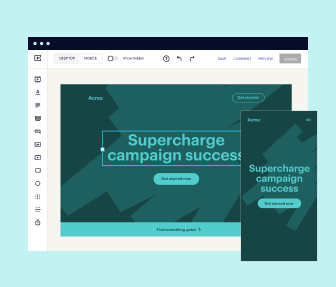
Loads fast and looks polished on any device
Every template is responsive, which means they present professionally on any device and load blazingly fast with our Thor Render Engine. You can also power them up with Google AMP technology to deliver an unparalleled mobile experience and drive higher conversions.
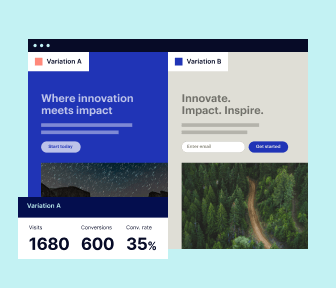
Robust analytics & experimentation
Get real-time updates and reporting across all your devices, showing the number of visitors, conversions, cost-per-visitor, and cost-per-lead. Launch AI-powered experiments, run A/B tests, and use heatmaps to analyze user behavior, then optimize your landing page to maximize conversions.

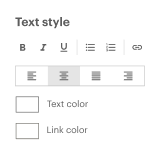
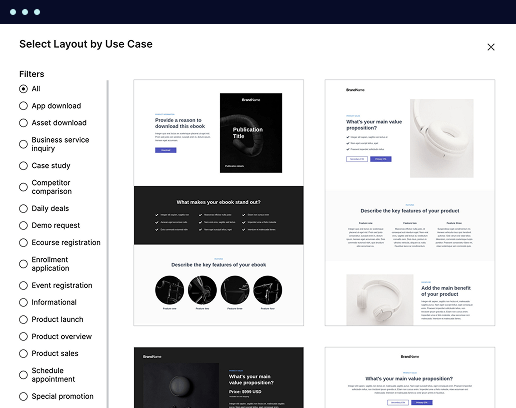
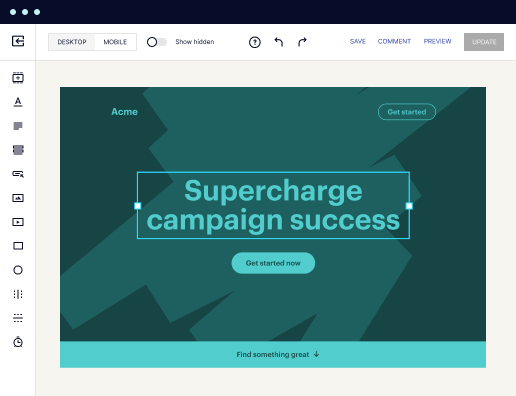
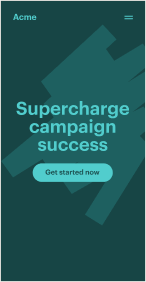
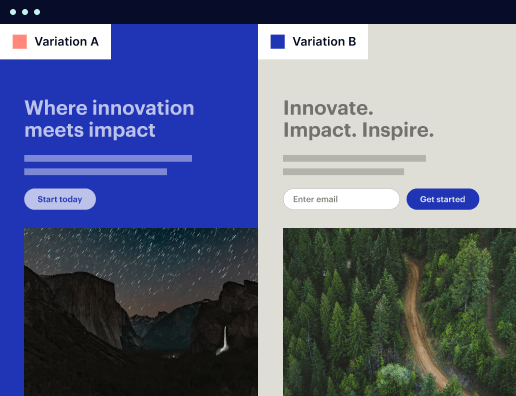

Easy to build without coding
With the intuitive drag-and-drop builder, anyone on your team can create high-converting pages without any knowledge of code or design. Make enhancements to your landing page with custom widgets using Javascript, HTML/CSS, or third-party scripts.
Multiple layouts for any industry and goal
Select from 500+ landing page layouts built to boost conversions across industry-specific scenarios. Customize them by adjusting fonts, adding images, and generating on-brand content with the AI assistant. Quickly scale with Instablocks® and Global Blocks that you can save, reuse, and update globally.
Loads fast and looks polished on any device
Every template is responsive, which means they present professionally on any device and load blazingly fast with our Thor Render Engine.
Robust analytics & experimentation
Get real-time updates and reporting across all your devices, showing the number of visitors, conversions, cost-per-visitor, and cost-per-lead. Launch AI-powered experiments, run A/B tests, and use heatmaps to analyze user behavior, then optimize your landing page to maximize conversions.
All the features you need to build lead-generating landing pages
Explore more featuresLearn how to build top-performing landing pages for any goal
FAQs
Leading the way in building high-performing landing pages





Maximize ROI with Instapage’s powerful landing page and CRO platform
In today's competitive digital landscape, effective landing pages serve as the backbone of successful marketing campaigns, and Instapage stands out as a leading landing page and conversion rate optimization (CRO) platform. With over 100 customizable templates and exceptional lead generation features, Instapage allows businesses in various sectors to accelerate their marketing efforts and maximize ROI effortlessly. This guide explores how to leverage these tools to your advantage.
Understanding the power of landing pages
Landing pages are specialized web pages designed to capture leads or convert visitors into customers. By using Instapage, marketers can take advantage of a seamless page-building process to create attractive and high-converting landing pages swiftly. Here’s why high-quality landing pages are crucial:
- Boost conversions: High-converting landing pages are essential for increasing sales and lead generation.
- Enhance brand perception: Well-designed landing pages promote professionalism and trust.
- Improve campaign effectiveness: Targeted landing pages can significantly increase engagement rates.
Step 1: Choosing the right template
With Instapage, selecting a template sets the foundation for your landing page. Start by reviewing the extensive library of conversion-focused layouts:
- Opt for industry-specific designs that resonate with your target audience.
- Utilize A/B testing features to find the most effective template for your campaign.
- Leverage Instablocks for reusable sections that maintain consistency across your pages.
Step 2: Optimizing your landing pages
After selecting a template, it's time to enhance your page for optimal performance. Instapage offers key features that facilitate this process:
- Use heatmaps to monitor visitor behavior and tweak page elements accordingly.
- Run A/B tests to pinpoint the best-performing content and design choices.
- Implement CTA buttons and lead capture forms effectively to drive user actions.
Step 3: Personalizing user experience
Delivering a personalized experience significantly increases engagement and conversion rates. Utilize the personalization tools in Instapage:
- Incorporate dynamic text replacement to tailor content to various audience segments.
- Align your ads with unique landing pages through AdMaps for cohesive marketing efforts.
- Track audience-specific metrics to fine-tune messaging and offers based on actual performance.
A well-designed landing page is a critical asset that drives the success of digital marketing initiatives. By leveraging Instapage's powerful features, you can craft pages that not only perform but also deliver a personalized and memorable user experience.
Ready to elevate your marketing campaigns? Start using Instapage today to create landing pages that convert visitors into loyal customers.
People also ask about Event registration page template for Node.js developers
Event registration page template for Node.js developers
Understanding the importance of event registration page templates in Node.js development
In the current digital landscape, event registration pages play a critical role in facilitating event management. They are the first point of contact between event organizers and participants, ensuring that users can easily navigate the registration process. As Node.js developers, creating an efficient event registration page template can significantly impact user engagement and conversion rates.
User experience is paramount during the signup process. A well-designed registration page can streamline the journey from event interest to registration completion. It allows users to find essential information seamlessly, enhancing their likelihood of attending the event.
Overview of event management and registration.
Importance of user experience during the event signup process.
Key features of an effective registration page
An effective registration page must be designed with user-friendly principles in mind. It should include visual clarity, intuitive forms, and quick load times to minimize user frustration. Moreover, given the prevalence of mobile browsing, it should also be mobile-responsive to cater to users on various devices.
User-friendly design principles.
Intuitive navigation and mobile responsiveness.
Setting the foundation: Essential components of an event registration page template
Creating a robust event registration page begins with integrating essential components that ensure functionality and a smooth user experience. Key functionalities like form fields to capture user information, including name and email, are indispensable for identifying participants and maintaining contacts post-event.
Another vital component is payment integration. Secure methods for transaction processing not only enhance user trust but also streamline the registration process for paid events. Furthermore, providing event details such as date, time, and location directly on the registration page equips users with necessary information upfront.
Form fields for user information: Name, email, etc.
Payment integration: Secure methods for transaction processing.
Event details display: Date, time, location, and other specifics.
Support and accessibility features
An ideal registration page must also incorporate support and accessibility features. Accessibility for users with disabilities is essential, allowing everyone the opportunity to participate in events. This includes providing alternative text for images, keyboard navigation, and ensuring compatibility with assistive technologies.
Accessibility for users with disabilities.
Multi-language support and browser compatibility.
Leveraging Node.js for event registration page development
Node.js proves to be a powerful tool for creating event registration pages due to its unique features. One significant advantage is asynchronous processing, which allows web applications to handle multiple requests simultaneously. This capability is crucial during high-traffic events when many users attempt to register concurrently.
Moreover, Node.js is inherently scalable. As event registration demands increase, Node.js can efficiently handle spikes in user traffic without compromising performance. Real-time functionalities, such as notifications on registration confirmations or updates, can also be seamlessly integrated into your event registration page.
Asynchronous processing for improved performance.
Scalability and real-time capabilities for high-traffic events.
Setting up your Node.js environment
Before diving into development, setting up your Node.js environment is essential. First, ensure that you have Node.js installed on your machine, along with necessary packages to support your web application. Common packages might include Express.js for creating server routes and MongoDB or SQL for database management.
Once the prerequisites are met, initialize your project by creating a directory structure that hosts core files such as index.js for server configuration, and additional routes and utility files. This structure will keep the project organized as it scales.
Prerequisites: Installation of Node.js and necessary packages.
Initializing a project: Directory structure and core files.
Crafting an event registration page template: Step-by-step guide
Now that the foundation is set, let’s delve into crafting your event registration page template. Start with building the basic template structure, utilizing HTML for layout. Incorporate semantic elements to enhance clarity and SEO effectiveness. Use properly structured elements to ensure search engines better understand the content.
CSS will enhance the visual appeal of your registration page. Implement styles that align with your branding while ensuring readability. Stick to a consistent color scheme and typography that keeps in line with your event’s theme.
HTML layout: Utilizing semantic elements for clarity.
CSS styles: Ensuring a visually appealing design.
Implementing dynamic features with Node.js
Dynamic features are crucial in ensuring interactivity on your event registration page. Handling form submissions is a key functionality to implement. Use back-end validation in Node.js to ensure that input data is correctly formatted and secure before processing the registration.
User sessions can be managed with cookies, enhancing personalization during users' subsequent visits. This can include remembering user preferences or offering ticket discounts based on past attendance. Moreover, using WebSockets or AJAX will allow for real-time updates on event registration statuses, creating a more engaging user experience.
Handling form submission: back-end validation.
Managing user sessions with cookies: Access and personalization.
Real-time updates for events using WebSocket or AJAX.
Enhancements to ensure a seamless user experience
To further enhance your event registration page, consider integrating third-party libraries that provide added functionalities. For instance, calendar integration can allow users to quickly note down event details, reducing the chances of them forgetting important dates. Additionally, social media sharing tools can amplify event visibility and encourage participation through peer influence.
Calendar integration for event dates.
Social media sharing tools to increase event visibility.
Utilizing cookie settings for personalized user experience
Implementing cookie settings also plays a crucial role in personalization. With adequate configurations, you can ensure compliance with privacy policies while improving the user experience. This means allowing users to control what data they share and tailoring interactions based on their preferences.
Ensuring compliance with terms of use and privacy statement.
Configuring cookie preferences for user experience enhancement.
Testing and optimizing your event registration page template
Testing your event registration page is essential to ensure its functionality across different browsers and devices. Cross-browser testing strategies can help identify any compatibility issues before launch. Tools like BrowserStack can be useful for checking site behavior in various environments.
Mobile responsiveness is another crucial aspect to verify. With increasing mobile device usage, ensuring that your page renders well on small screens is critical for retaining user interest. Using responsive design techniques will ensure that your template fits comfortably on devices of all sizes.
Cross-browser testing strategies.
Mobile responsiveness checks.
Gathering user feedback for continuous improvement
After launching your event registration page, gathering user feedback should be an ongoing process. Implement feedback mechanisms such as surveys and follow-ups to understand user experiences better. This will provide insights into areas needing improvement or enhancement.
Additionally, analyzing user engagement metrics, such as bounce rates, can help in pinpointing where enhancements are needed. By continuously iterating and optimizing based on user behavior, you ensure that your registration page remains effective and user-focused.
Implementing feedback mechanisms: Surveys and follow-ups.
Analyzing user engagement metrics: Reducing bounce rates.
Deploying your event registration page template
With testing complete, it’s time to prepare for the launch of your event registration page template. Adhering to best practices during deployment is essential. Selecting a reliable hosting provider can ensure that your page remains accessible and performs well even under heavy traffic.
Version control is also a critical component of deployment. Utilizing Git to manage code changes allows for efficient collaboration and easier troubleshooting. Continuous product updates based on user feedback will help keep your template relevant and effective throughout its use.
Selecting a reliable hosting provider.
Version control and continued product updates.
Ongoing maintenance and support
Once launched, ongoing maintenance and support are vital for user satisfaction. Consider utilizing help desk specialists to address user inquiries promptly. This not only builds trust but also ensures that any issues encountered by users can be quickly resolved.
Creating a knowledge base can be beneficial for both users and your support team. This resource can address common cases and troubleshooting guides, empowering users to find solutions independently while reducing the burden on support staff.
Utilizing help desk specialists for user inquiries.
Creating a knowledge base for common cases and troubleshooting.
Future-proofing your event registration page
Future-proofing your event registration page involves staying proactive about user expectations and technological advances. Keeping up with new product versions and functionalities ensures that your page can leverage the latest developments in web technology. Adapting to changes in user preferences will maintain user engagement over time.
Incorporating user feedback into future template versions is vital for staying relevant. Regularly revising your approach based on what users want can significantly enhance their experience and foster loyalty.
Staying updated with product versions and new functionalities.
Incorporating user feedback into future template versions.
Planning for scale: Subscription models and pricing strategies
When considering scalability, planning various subscription models can cater to diverse event needs. Different tiers can be structured based on features and expected attendance sizes. This flexibility ensures that all potential users find a suitable package.
Adapting the template to cater to various event scales and types enhances market reach. It’s important to consider both small meetups and large conferences, ensuring that the functionality remains robust regardless of the event size.
Different subscription tiers for varying event needs.
Adapting the template to cater to various event scales and types.
Ready to skyrocket conversions?
Supercharge your ad campaigns with high-performing landing pages
Get started